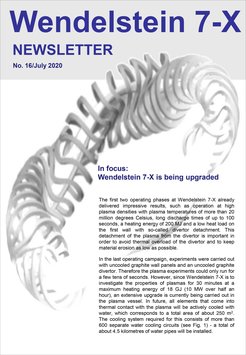New issue of the Wendelstein Newsletter
Information around and about the Wendelstein 7-X fusion device
The newsletter reports on current developments throughout the Wendelstein 7-X stellarator. Issue 16/2020 deals with upgrading of the device for the next experiment campaign.

Whereas Wendelstein 7-X has so far been operated with uncooled wall cladding and divertor plates, all parts in the plasma vessel that come into thermal contact with the hot plasma are currently being replaced by water-cooled elements – a total area of about 250 square metres. Instead of the previous plasmas lasting several tens of seconds, it will then be possible to study plasmas at a maximum heating energy of 18 gigajoules for 30 minutes.
At the same time, the equipment for plasma heating will be expanded: ten microwave transmitters of the electron cyclotron resonance heating with a total power output of 8 megawatts and a neutral particle injector were already in operation. Now a second injector is being added. The total power of the neutral particle heating system will thus increase to 7 megawatts. Another new feature is the ion cyclotron resonance heating with a radio wave heating capacity of 1.5 megawatts. Seven new systems will be added to the range of diagnostics that monitor the plasma.
Because the corona protection measures inevitably delay the conversion work, the assembly plan for Wendelstein 7-X is currently being revised. It is already clear that plasma operation will not be able to start in 2021 as originally planned. With the start of the experiment, after the long pause, higher heating capacities and longer plasma pulses will be cautiously approached. The energy converted in one plasma pulse will then be gradually increased to a maximum of 18 gigajoules – a scientific and technical programme lasting several years.
To download the newsletter >>
